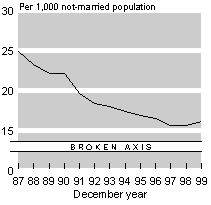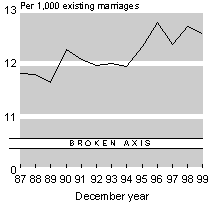Family Trends
I Do, I Can, I WillThe difficulty with marriage is that we fall in love with a personality, but must live with a character. - Peter De Vries Marriage is the alliance of two people, one of whom never remembers birthdays - Ogden Nash Marriage is like a phone call in the night: first the ring, and then you wake up. - Evelyn Hendrickson
The late Princess Diana's parents on their wedding day in 1954 Serial monogamy may be replacing marriage-for-life. But divorce rarely makes everyone happy. Four new books look at an institution under fire For most of the past two millennia, western society has had at its core a contract binding together a man and a woman for life. Now the contract is falling apart. Men and women still want to enter it. But, in barely 50 years, cohabitation before marriage has become the norm in many countries; 40% of American children are born out of wedlock; and the assumption that marriage is for life has vanished. Two-fifths of American first marriages (and an even higher proportion of second and subsequent ones) are now likely to end in divorce. None of these authors focuses on why marriage, having endured so long, is now in such a mess. Marilyn Yalom, whose new book, A History of the Wife, appears in February, probably gets closest when she points out that the old "quid pro quo" version of marriage, where men supported their wives financially and women in exchange cared for them and their children, has broken down. Meanwhile, the new marital model of equal sharing at home and at work has not yet "been fully realised." Certainly there is a suspiciously close correlation between the rise in women's employment and their earning power relative to that of men on the one hand, and the rise in marital breakdown on the other. Many women no longer need men to support them and their children financially; in addition, once out in the workplace, women whose marriages are not happy may find new and preferable partners. Going out to work may not increase conjugal unhappiness, but it certainly gives wives an easier way out. As that escape route began to open up in the middle of the 20th century, it seemed to promise bliss to those wives whose marriages were torture. Nancy Cott's study of marriage as a public institution, Public Vows: A History of Marriage and the Nation, is full of reminders of how until very recently the law subjugated women to their husbands. After Princess Diana's mother, the former Viscountess Althorp (pictured above on her wedding day in 1954), left her husband she promptly lost custody of her children. Ms Cott, a history professor at Yale, quotes an essayist of the 1850s observing approvingly that a husband "represents the wife in the political and civil order." Less than a century ago, the Supreme Court could still define a husband's right to exclusive sexual intercourse with his wife "a right of the highest kind, upon which the whole social order rests." The exemption from the courts of marital rape began to disappear only in 1984. Even now, argues Ms Yalom, a professor at the Institute for Women and Gender at Stanford University, men get a better deal from marriage. On a whole range of measures of mental health - suicide, depression, nervous breakdowns - single men do worse than married men, but single women do better than their married sisters. Husbands, it is often reported, like being married more than their wives do. The burden of combining child care and family obligations with employment falls mainly on women. It may be unsurprising that many women, given the financial and legal freedom to escape from marriage, head for the divorce courts. But it is not clear that divorce makes people happier. Hence the tub-thumping Case for Marriage made by Linda Waite, a professor of sociology at the University of California, Davis, and Maggie Gallagher, director of the Marriage Project at the Institute of American Values. Together they sweep up a host of studies which suggest that marriage increases health and happiness for both sexes. Some of those gains seem to come from the sheer economic efficiency of marriage: two people can save money by living in one household and specialising in (or even sharing) the work of supporting it. "Just getting married," say the authors enticingly, "can boost your standard of living by about a third." If marriage brings benefits to both men and women, it is even better for children. With the rise in the divorce rate has come a sobering realisation: the interests of individual family members may differ. What makes quarrelling mothers and fathers happier may not do quite the same for their children. Judith Wallerstein, a senior lecturer at the University of California, Berkeley, and author of The Unexpected Legacy of Divorce: A 25-Year Landmark Study, has probably done more than anyone to bring this uncomfortable truth to the attention of America's separating spouses. Her somewhat anecdotal research methods - a small longitudinal sample, coupled with many stories from her counselling work - make many other academics squirm. But a growing body of evidence suggests that her basic points are right: children of divorce are more likely to have problems at school, to dropout of education and to have difficult relationships than those who lose a parent through death or whose parents' marriage survives. If, as seems possible, children are the victims of the liberation of women, how should governments respond? By returning to the tax regimes that favour married couples? By making divorce harder to obtain? Ms Cott points out that marriage is not merely a private arrangement between two people; it requires public affirmation, and carries distinct public rights and benefits. Over the years, governments have whittled away these special rights, extending them to other relationships. Some campaigners, such as Ms Waite and Ms Gallagher, would like to see that trend reversed, to reinforce the special private advantages they see arising from marriage. They may in time succeed. But whatever the impact of divorce on children, no government is likely to deprive women of the freedoms they have won, in marriage and at work, over the past 50 years.
A History of the Wife by Marilyn Yalom HarperCollins; 480 pages; $27.50. To be published in Britain by Pandora in March. Public Vows: A History of Marriage and the Nation by Nancy F Cott Harvard University Press; 304 pages; $27.95 and £19.50. The Case for Marriage: Why Married People Are Happier, Healthier, and Better Off Financially by Linda J Waite and Maggie Gallagher Doubleday; 272 pages; $24.95 The Unexpected Legacy of Divorce: A 25-Year Landmark Study by Judith S Wallerstein, Julia M Lewis and Sandra Blakeslee. Doubleday; 272 pages; $24.95 Source: The Economist 6 January 2001 economist.com
Sex and Fun - but No Wedding Bells?Marriage is the one subject on which all women agree and all men disagree. - Oscar Wilde (1854-1900) Do They Really Mean What They Say?New York - Romance and marriage are out while casual sex and low-commitment relationships are in among young Americans, researchers says. Men and women in their 20s are not interested in finding marriage partners when they date, according to a study by Rutgers University's national marriage project. Instead, as the study's title suggests, they are more concerned with Sex without Strings, Relationships without Rings. "Today's singles scene is not oriented toward marriage, nor dedicated to romantic love as it has been in the past," Popenoe, sociology professor at the New Jersey university, says. The study focused on unmarried men and women aged 21-29 in five cities. Young people in America are more concerned with having fun and making money and less focused on forming lasting relationships, the study says. Oddly, most of the young men and women expect to meet and marry someone who fulfills their emotional and spiritual needs, the study says. The problem, researchers point out, is that young people's present mercenary mating habits do not easily lead to the fulfillment of that goal. Barbara Dafoe Whitehead, co-author of the report, says the high incidence of divorce among their parents means young people do not count on having lasting relationships and they have a calculated approach. Instead, they focus on themselves. - Reuters Source: The Dominion Thursday 8 June 2000 Also see:
The following short article was taken from an issue of the Anderson Valley Advertiser. You need not read the detail, as that isn't important. Births A girl, Hannah Kristian Kuuipo Peterman, born July 5, 2000 at Ukiah Valley Medical Center, to Eric Lee Peterman, 38, and Welette L Y N Ching, 42. A girl, Mitzi Ruelas, born July 19, 2000 at Ukiah Valley Medical Center, to Cesario Ruelas Rosas, 41, and Eva Maria Muniz, 34. A boy, Nathaniel Earl Schleif, born July 21, 2000 at Ukiah Valley Medical Center, to Jack Earl Schleif, 21, and Tracy Leann Way, 19. A girl, Mariah Maiselee Shaver, born July 30 at Ukiah Valley Medical Center, to Mariah Lester Shaver, 20, and Bonnie Sue Dunham, 19. A boy, Trenton Patrick Allen Lockhart, born July 27, 2000 at Ukiah Valley Medical Center, to Jaymz Silvio-Gerrett Lockhart, 23, and Amber Denise Duncan, 21. A boy, Martin Octavio Martinez Guiterrez, born July 12, 2000 at Ukiah Valley Medical Center, to Neftali Santiago Guiterrez Rojas, 21, and Reyna Hernandez Martinez, 23. A boy, Enrique Omar Mendoza, born July 19, 2000 at Ukiah Valley Medical Center to Jose Enrique Mendoza, 34, and Maria Dolores Ramirez, 37. A boy, Axel Jesus Aparicio, born July 31, 2000 at Ukiah Valley Medical Center to Jesus Aparicio, 25, and Elizabeth Sanchez, 30. A boy, Joshua James Franklin Betts, born July 20, 2000 at Ukiah Valley Medical Center, to William Roy Bett Sr, 30, and Jeannine Rose Demeter Betts, 24.
Nine babies were born at the Ukiah Valley Medical Center (in Northern California) during the month of July. Of these presumably quite random 9, the woman was older than the man 44% of the time, 22% of the couples had the same last name, and 2/3 of the babies were boys.
What about New Zealand? I downloaded the following information off stats.govt.nz website. The general marriage rate (number of marriages per 1,000 not-married population aged 16 years and over) increased from 15.7 in 1998 to 16.2 in 1999. The latest rate is about 1/3 of the post-World War II peak of 45.5 per 1,000 recorded in 1971. Many factors have contributed to the large fall in the marriage rate and these include: the growing number of de facto relationships, a general trend towards delayed marriage and increasing numbers of New Zealanders opting to remain single.
Age At First MarriageThe trend towards later marriage is continuing. Formal marriages are being increasingly postponed and fewer New Zealand men and women marry in their teens. In 1999 only 665 teenage girls were married, compared with 8,717 in 1971. Teenagers comprised 32% of all brides in 1971, but just 3% in 1999. The median age (half of those marrying are older than this age) of first-time grooms in 1999 was 28.9 years. This is almost 6 years older than those who married for the first time in 1971. Similarly, the median age of first-time brides has risen by about 6 years since 1971, from 20.8 years to 27.0 years. Women still marry men older than themselves, but the gap between their average age at first marriage has narrowed. In the mid-1960s this gap was about 3.0 years, but by 1999 it had narrowed to 2.0 years. De Facto UnionsWith an increasing proportion of New Zealand men and women remaining single through their 30s, it appears likely that fewer will ultimately marry. A growing proportion of New Zealanders, like their counterparts in Australia, Northern America and Europe, live together without legalising or formalising their union. In 1996, about one in four men and women aged 15 - 44 years who were in partnerships, were not legally married. De facto unions are more common than formal marriage among younger New Zealanders. For men and women under 25 years of age, those living in a de facto relationship outnumbered those legally married. The five-yearly Census of Population and Dwellings is the primary source of information on these de facto unions. Marriage statistics only provide information on formally registered marriages.
For articles on affair motivators, changing relationships, do-it-yourself psychotherapy, lies, insincerity, social graces, cosmetic surgery, roots of culture, self-deception, love,
and reunions of lost relatives click the "Up" button below to take you to the Table of Contents for this Relationships section. |
 Animals
Animals Animation
Animation Art of Playing Cards
Art of Playing Cards Drugs
Drugs Education
Education Environment
Environment Flying
Flying History
History Humour
Humour Immigration
Immigration Info/Tech
Info/Tech Intellectual/Entertaining
Intellectual/Entertaining Lifestyles
Lifestyles Men
Men Money/Politics/Law
Money/Politics/Law New Jersey
New Jersey Odds and Oddities
Odds and Oddities Older & Under
Older & Under Photography
Photography Prisons
Prisons Relationships
Relationships Science
Science Social/Cultural
Social/Cultural Terrorism
Terrorism Wellington
Wellington Working
Working Zero Return Investment
Zero Return Investment


